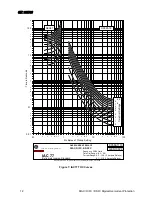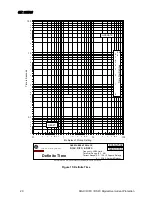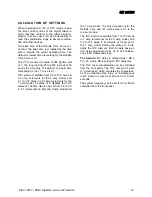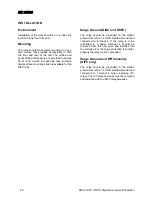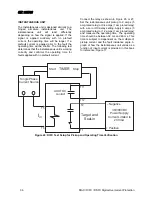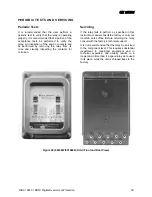
*(.&
24
DIAC / DIFC / DSFC Digital Overcurrent Protection
HARDWARE DESCRIPTION
Case
DIAC and DSFC
The DIAC and DSFC relays consist of a case,
cover, support structure, and a connection plug
to make up the electrical connection. The case is
shown in Figures 20 and 22. The external con-
nections are shown in Figure 18. It has 10 con-
nection points and a CT shorting bar. As the
connection plug is withdrawn the trip circuit is
broken prior to the current shorting bar engage-
ment. The window provides visual indication of
the CT shorting.
DIFC
The DIFC relays consist of a molded case,
cover, support structure, and a connection plug
to make up the electrical connection. The case is
shown in Figures 20 and 21. The external con-
nections are shown in Figure 19. It has 14 con-
nection points and a visible CT shorting bar. As
the connection plug is withdrawn the trip circuit is
broken prior to the current shorting bar engage-
ment. The window provides visual indication of
the CT shorting.
Adjustments
All customer settings are accessible from the
front of the relay. The cover must be removed to
gain access to the settings. The cover has provi-
sions for a sealing “wire.” The settings are left to
right, pickup current level for the time element,
time dial, curve selection, frequency / reset time,
pickup current level for the instantaneous ele-
ment, and the instantaneous element time delay.
The settings are all calibrated and are set by
turning the rotary switch to the desired value.
The switches are recessed; a small screwdriver
is required to make the adjustment.
The relay may be supplied with one of three
pointer styles as shown. The color is the color of
the indicator, note the arrow location, all
switches are shown in the 9:00 position.
The TOC pickup current is set directly in Amps
with two rotary switches. An arrow is used to in-
dicate setting position. Setting the TOC or the
IOC pickup current between, but not including 0
and a value less than minimum 0.5 (5 amp) or
0.1 (1 amp) will result in the relay defaulting to its
minimum setting. Setting the TOC or IOC pickup
current to 0 will disable their respective ele-
ments. Although the time dial can be set to a
value less than minimum the relay will use the
minimum setting.
The relay also provides a front panel trip circuit
test. An actuating lever that must be pulled and
then lifted is provided to trip the device con-
nected to the relay. The level directly operates
the trip contacts.
3RLQWHU VW\OHV
<HOORZ
2UDQJH
:KLWH
Targets And Indicators
The yellow pick-up LED will come on solid for the
TOC function when the input current to the relay
is higher than the set point. The location of the
LED is between the frequency/reset switch and
the IOC pickup level switch.
It may be desirable to know when the relay is
powered up and operating. The relay must be
energized at or above 95% of the minimum pos-
sible setting and below pick-up set point. To ac-
tivate, turn the SELECT switch one step clock-
wise or one step counterclockwise. This will
cause the pickup LED to blink at 4 second inter-
vals while current is below the pick-up set point.
Minimum current is 95% of minimum TOC
pickup setting for both the 1amp and 5 amp
models. A blinking LED indicates the microproc-
essor is executing code and outputting signals.
The relay uses a target and seal-in unit as its
tripping element. The relays have one TOC tar-
get and one IOC target. The targets are me-
chanically latched when the function trips. The
trip contacts will remain closed until the trip cir-
cuit current drops below 0.19 A.
NOTE: Do not attempt to reset the trip target
while DC is still applied – this may damage
the output contact.
Summary of Contents for DIAC
Page 2: ......



